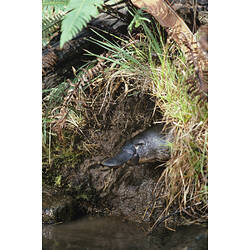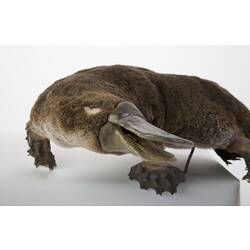General Description
Body flattened and covered in short brown fur. Wide flat bill and webbed feet. Tail flat. Platypus are sometimes mistaken for Water Rats, Hydromys chrysogaster, when swimming on the surface. Males have a venomous spur on the hind foot. Up to 55 cm long (bill to tail).
Biology
Platypus use sensory organs in their bill to detect prey, which includes larval mayflies, caddisflies and small molluscs. The Platypus is one of the only mammals to lay eggs instead of giving birth to live young. Females lay two eggs in a nursery burrow, which then take two weeks to hatch.
Distribution
Eastern mainland Australia and Tasmania.
Habitat
Freshwater rivers and streams.
More Information
-
Animal Type
-
Animal SubType
-
Brief Id
An egg-laying mammal most often seen swimming and diving in freshwater at dusk. Platypus have a broad flat bill, short wide tail and webbed feet.
-
Colours
Brown
-
Maximum Size
55 cm
-
Habitats
-
Where To Look
-
When Active
Nocturnal, Diurnal
-
Diet
Carnivore
-
Diet Categories
Invertebrates, Crustaceans
-
Hazards
Males have a venomous spur on the hind foot.
-
Endemicity
-
Commercial
No
-
Conservation Statuses
CITES: Not listed, FFG Threatened List: Vulnerable, EPBC Act 1999: Not listed, IUCN Red List: Near Threatened
-
Taxon Name
-
Common Name
Platypus
-
Kingdom
-
Phylum
-
Subphylum
-
Class
-
Order
-
Family
-
Genus
-
Species Name
anatinus








